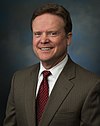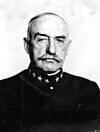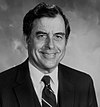| Name | Class year | Notability | References |
|---|
| William D. Leahy | 1897 | Chief of Naval Operations (1937–39); became the first Admiral of the Fleet during World War II and crafted future thought leadership; served as Chief of Staff to the Commander in Chief, the role model for the first Chairman of the Joint Chiefs of Staff; Governor of Puerto Rico (1939–1940); ambassador to Vichy France; father of Rear Admiral William Harrington Leahy | [i] |
| Alfred Wilkinson Johnson | 1899 | Vice Admiral; destroyer, light cruiser, and battleship commander; Director of Naval Intelligence; Commander of the Atlantic Squadron; recipient of the Distinguished Service Medal; U.S. Minister to Nicaragua; married to the great-niece of U.S. Senator Ira Harris and father-in-law of U.S. Ambassador Charles Burke Elbrick | [250] |
| Julius A. Furer | 1901 | Rear Admiral; recipient of the Navy Cross; USS Julius A. Furer was named for him | |
| Ernest King | 1901 | Fleet Admiral; Chief of Naval Operations in World War II (1942–45) | [i][251] |
| William "Bull" Halsey Jr. | 1904 | Fleet Admiral; commander of the United States Third Fleet during part of the Pacific War against Japan | [252][253] |
| Chester W. Nimitz | 1905 | Fleet Admiral; held the dual command of Commander-in-chief, United States Pacific Fleet ("CinCPac" pronounced "sink-pack"), for U.S. naval forces and Commander in Chief, Pacific Ocean Areas (CinCPOA), for U.S. and Allied air, land, and sea forces during World War II; Chief of Naval Operations (1945–47) | [i][208][209] |
| Harold Medberry Bemis | 1906 | Rear Admiral; recipient of the Navy Distinguished Service Medal | |
| Frank Jack Fletcher | 1906 | Admiral; recipient of the Medal of Honor for saving hundreds of refugees during the United States occupation of Veracruz in April 1914; operational commander at the pivotal Battles of Coral Sea and of Midway; nephew of Admiral Frank Friday Fletcher | [f][254] |
| Henry Kent Hewitt | 1906 | Admiral; recipient of the Navy Cross commanding USS Cummings during World War I; commander of the United States Eighth Fleet through the amphibious invasions of Casablanca, Gela, Salerno, and Southern France | [255] |
| John S. McCain Sr. | 1906 | Vice Admiral, posthumously promoted to Admiral; pioneer of aircraft carrier operations; commanded Fast Carrier Task Force in World War II. He and his son John S. McCain Jr. are the first father-son four-star Admirals in US Navy history; grandfather of John S. McCain III, also an Academy graduate, and 1908 Republican Presidential Candidate. | [256] |
| Raymond A. Spruance | 1906 | Admiral; destroyer and battleship commander; Commander of the United States Fifth Fleet; Commander-in-Chief of the United States Pacific Fleet recipient of the Navy Cross and the Navy Distinguished Service Medal; U.S. Ambassador to the Philippines; USS Spruance (DDG-111), USS Spruance (DD-963), and Spruance-class destroyer series of ships were named for him | [131] |
| Jonas H. Ingram | 1907 | Admiral; recipient of the Medal of Honor for courage and leadership in handling an artillery and machine gun battalion during the United States occupation of Veracruz in April 1914; Navy Cross recipient for actions during World War I; commander, United States Atlantic Fleet during World War II; football player and head football coach at the Academy | [f][257][258] |
| Thomas C. Kinkaid | 1908 | Admiral; commander U.S. 7th Fleet; commander Eastern Sea Frontier and the Atlantic Reserve Fleet | [259] |
| Hugh J. Knerr | 1908 | Major general; observation squadron commander; Commander of the Air Technical Service Command; recipient of the Distinguished Service Medal, the Legion of Merit, and the Bronze Star Medal | [260] |
| Robert Grimes Coman | 1909 | Commodore; destroyer; collier; and battleship commander | |
| Theodore S. Wilkinson | 1909 | Vice-Admiral; recipient of the Medal of Honor for courage and leadership during the United States occupation of Veracruz in April 1914; veteran of World War I and World War II; director of Office of Naval Intelligence when Pearl Harbor was attacked in 1941 | [f][257][261] |
| Marc Mitscher | 1910 | Admiral; recipient of three Navy Crosses; commander of the Fast Carrier Task Force in World War II; Commander-in-Chief, U.S. Atlantic Fleet | [262] |
| George McMillin | 1911 | Rear admiral; 38th and final Naval Governor of Guam (1940–41); Surrendered to the Empire of Japan during the First Battle of Guam | [181] |
| Charles A. Lockwood | 1912 | Vice Admiral; gunboat, destroyer, and submarine commander; recipient of three Navy Distinguished Service Medals; USS Lockwood was named for him | [263] |
| Pedro del Valle | 1915 | First Hispanic Marine Corps officer to reach the rank of lieutenant general; served in World War I, Haiti, and Nicaragua during the so-called Banana Wars of the 1920s, the seizure of Guadalcanal, and later as Commanding General of the U.S. 1st Marine Division during World War II | [264][265] |
| Frank Edmund Beatty Jr. | 1916 | Vice Admiral; destroyer and light cruiser commander; recipient of the Navy Cross; son of Rear Admiral Frank E. Beatty | |
| Charles L. Carpenter | 1926 | Rear Admiral; Attack transport commander; recipient of the Navy Cross | [266] |
| Ralph A. Ofstie | 1919 | Vice Admiral; aircraft carrier commander; Deputy Chief of Naval Operations; was married to Captain Joy Bright Hancock | [267] |
| John W. Roper | 1918 | Vice Admiral; battleship commander; recipient of the Legion of Merit | [i][268] |
| Earl E. Stone | 1918 | Rear Admiral; battleship commander; Chief of Naval Communications; Commandant of the Naval Postgraduate School; recipient of two Legions of Merit | [268] |
| Jerauld Wright | 1918 | Admiral; destroyer and cruiser commander; commander of the United States Naval Forces Eastern Atlantic and Mediterranean; commander of the United States Atlantic Command; recipient of two Navy Distinguished Service Medals and the Silver Star; U.S. Ambassador to the Republic of China; son of Army Lieutenant General William M. Wright | |
| Winfield S. Cunningham | 1919 | Rear Admiral; Officer in Charge of U.S. forces during the Battle of Wake Island; seaplane tender commander; recipient of the Navy Cross | [269] |
| Charles B. McVay III | 1920 | Rear Admiral; captain of USS Indianapolis, which was sunk by a Japanese submarine in World War II and lost most of its crew to shark attacks after delivering nuclear bomb parts to Tinian | [270] |
| Walter Schindler | 1921 | Vice Admiral; recipient of the Navy Cross and the Silver Star | [271] |
| Rodger W. Simpson | 1921 | Rear Admiral; recipient of two Navy Crosses; destroyer commander | [272] |
| Irving Wiltsie | 1921 | Captain; seaplane tender and escort carrier commander; recipient of the Navy Cross and the Silver Star; USS Wiltsie was named for him | [273] |
| John Higgins | 1922 | Rear Admiral; recipient of the Navy Cross, the Navy Distinguished Service Medal, the Silver Star, and two Legions of Merit | [274] |
| Merrill B. Twining | 1923 | General; Chief of Staff of the United States Marine Corps Forces Pacific; nephew of Rear Admiral Nathan C. Twining and brother of Chairman of the Joint Chiefs of Staff Nathan Farragut Twining | [275] |
| Clarence Ekstrom | 1924 | Vice Admiral; recipient of the Navy Cross; escort carrier commander | [276] |
| Henry C. Bruton | 1926 | Rear Admiral; submarine and battleship commander; Director of Naval Communications; recipient of the three Navy Crosses and two Legions of Merit | [i][268] |
| Elmer Salzman | 1926 | Major general; recipient of the Navy Cross | [277] |
| James H. Flatley | 1929 | Vice Admiral; aviator; recipient of the Navy Cross, the Navy Distinguished Service Medal, and the Silver Star; USS Flatley was named for him | [278] |
| Warner S. Rodimon | 1929 | Captain, Rear Admiral; recipient of the Silver Star, the Bronze Star, Captain; USS Hopewell during retaking of Corregidor | [279] |
| William T. Nelson | 1930 | Rear Admiral; submarine commander | [280] |
| Marvin John Jensen | 1931 | Rear Admiral; submarine commander; recipient of the Silver Star | [281] |
| John O. Miner | 1931 | Rear Admiral; destroyer and battleship commander; U.S. Naval Attaché in Rome, Italy; recipient of the Silver Star and Legion of Merit | [i][268] |
| Louis Joseph Kirn | 1932 | Rear Admiral; aviator; recipient of the Navy Cross, the Navy Distinguished Service Medal, and the Distinguished Flying Cross | [282] |
| Edmond Konrad | 1932 | Rear Admiral; recipient of two Navy Crosses and the Silver Star | [283] |
| Waldemar F.A. Wendt | 1933 | Admiral; destroyer commander; Commander-in-Chief of the United States Naval Forces Europe; recipient of three Distinguished Service Medals | [284] |
| Bernard A. Clarey | 1934 | Admiral; submarine commander; commander of the United States Second Fleet; recipient of three Navy Crosses, five Distinguished Service Medals, and the Silver Star | [285] |
| Eli Thomas Reich | 1935 | Vice Admiral; as a Lieutenant Commander and commanding officer of USS Sealion, sank the Japanese battleship Kongō, the only Japanese battleship sunk by a submarine during World War II | |
| Louis Robertshaw | 1936 | Lieutenant general, Marine Corps; Marine aviator; recipient of three Distinguished Flying Crosses; World War II, Korean War, Vietnam War | [286] |
| William F. Bringle | 1937 | Admiral; aircraft carrier and supercarrier commander; commander of the United States Seventh Fleet; recipient of the Navy Cross | [287] |
| Harry Brinkley Bass | 1938 | Lieutenant Commander; Naval aviator; recipient of two Navy Crosses; USS Brinkley Bass named in his honor | [288] |
| Charles Francis McGivern | 1938 | Captain; submarine commander; recipient of two silver stars and the Legion of Merit | [289] |
| Carl Ferdinand Pfeifer | 1939 | Captain; destroyer commander; aide to Harry S. Truman and Dwight D. Eisenhower; recipient of the Silver Star and Legion of Merit | |
| Wilfred Holmes | 1922 | Captain; submarine commander; in May 1942 devised the ruse that revealed that "AF" was Midway Island, which led to the Japanese defeat at the Battle of Midway. | [290] |
| Carl Henry Jones | 1914 | Admiral; battleship commander; commanded the USS Maryland as commodore throughout 1943 and was named sub-area commander of the South Pacific after participating in the Battle of Tarawa. | [291] |








































